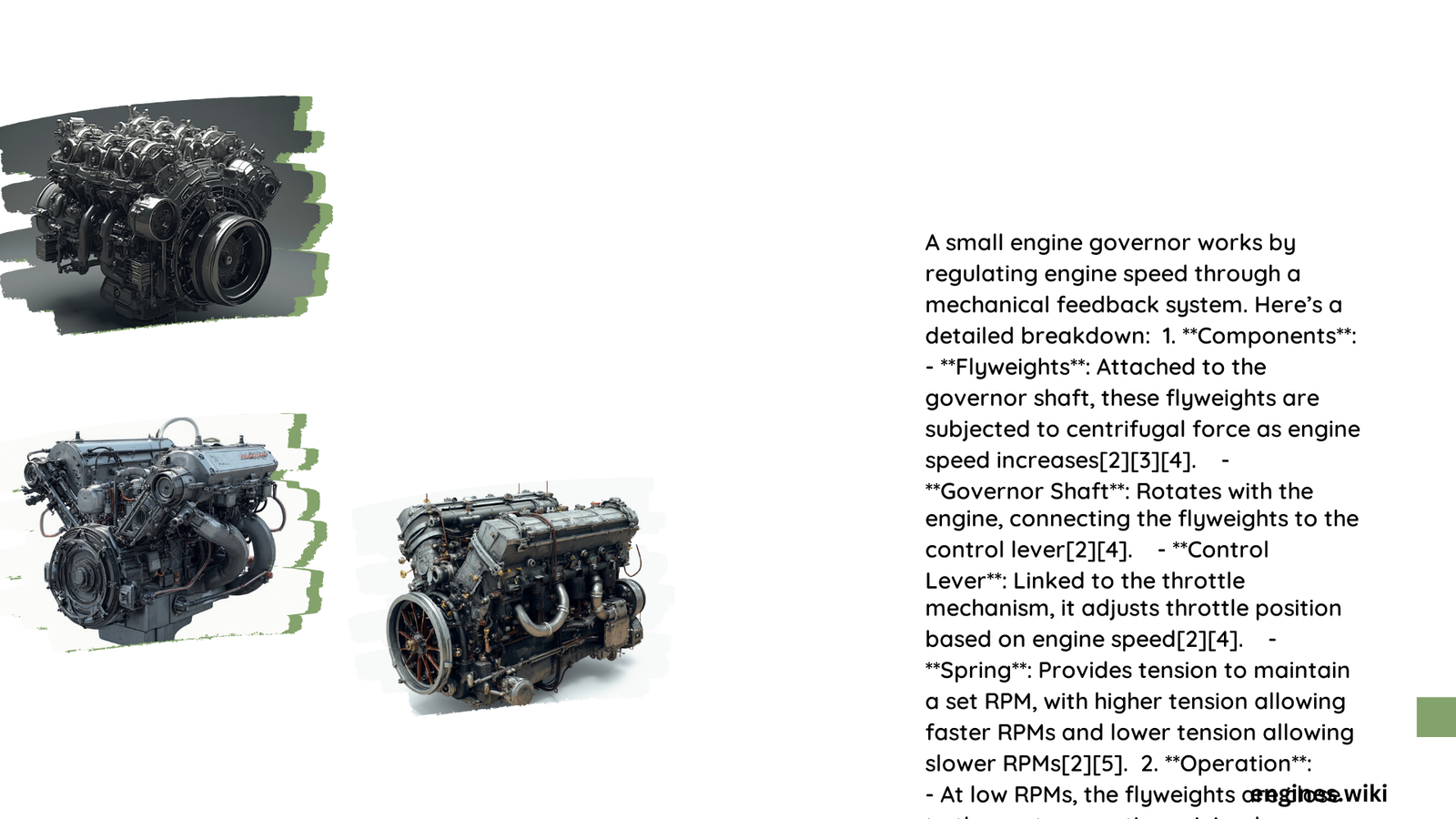Small engine governors are crucial components that regulate engine speed, ensuring optimal performance and preventing damage. They work by adjusting the throttle in response to changes in engine load, maintaining a consistent speed. This guide explores the mechanics, types, and adjustment techniques of small engine governors, providing insights into their operation and maintenance.
What Are the Different Types of Small Engine Governors?
Small engine governors come in three main types:
- Mechanical (Centrifugal) Governors
- Pneumatic Governors
- Electronic Governors
Each type operates on different principles but serves the same purpose of maintaining a steady engine speed under varying load conditions.
Mechanical (Centrifugal) Governors
Mechanical governors utilize the centrifugal force generated by the engine’s rotation to control speed. Here’s how they function:
- Components: Flyweights, gears, and linkages connected to the crankshaft
- Operation: As the engine speed increases, flyweights move outward, closing the throttle
- Load Response: When load increases, engine slows, flyweights move inward, opening the throttle
Pneumatic Governors
Pneumatic governors rely on air pressure changes to regulate engine speed:
- Key Component: Movable air vane affected by flywheel-generated air pressure
- Speed Control: Increased air pressure at higher speeds moves the vane, closing the throttle
- Advantage: Simple design, fewer moving parts compared to mechanical governors
Electronic Governors
Electronic governors use advanced technology for precise speed control:
- System: Speed sensors and computer-controlled actuators
- Operation: Continuously monitors engine speed and adjusts throttle electronically
- Benefit: Can maintain both minimum and maximum speeds with high accuracy
How Does Governor Spring Tension Affect Engine Performance?

Governor spring tension is a critical factor in the operation of mechanical and pneumatic governors:
- Function: Controls the force required to move the throttle
- Adjustment: Tightening increases maximum speed, loosening decreases it
- Impact: Proper tension ensures stable operation under varying loads
| Spring Tension | Effect on Engine |
|---|---|
| Too High | May cause stalling under load |
| Too Low | Risk of over-speeding |
| Optimal | Maintains consistent speed across load range |
What Are the Steps to Adjust a Small Engine Governor?
Proper adjustment of a small engine governor is essential for optimal performance:
- Identify Governor Type: Determine whether it’s mechanical, pneumatic, or electronic
- Locate Adjustment Points: Find the spring or adjustment screw
- Make Small Adjustments: Incrementally change tension or settings
- Test Under Load: Run engine and observe performance
- Fine-tune: Make further adjustments if necessary
Tips for Successful Governor Adjustment:
- Consult the engine manual for specific instructions
- Use proper tools to avoid damaging components
- Make small adjustments and test frequently
- Consider environmental factors like temperature and humidity
How Do Governor Settings Impact Engine Speed Control?
Governor settings directly influence an engine’s ability to maintain consistent speed:
- Idle Speed: Proper settings prevent stalling at low speeds
- Maximum Speed: Correct adjustment prevents dangerous over-speeding
- Load Response: Optimal settings ensure quick response to load changes
Common Issues Related to Incorrect Governor Settings:
- Inconsistent engine speed
- Poor fuel efficiency
- Excessive wear on engine components
- Difficulty starting or maintaining operation
What Are the Quantitative Aspects of Governor Spring Tension?
While exact measurements vary by engine model, understanding the general principles is important:
- Tension Range: Typically measured in inch-pounds or Newton-meters
- Adjustment Increments: Often in quarter or half turns of adjustment screws
- Performance Indicators: RPM changes per adjustment increment
Note: Always refer to manufacturer specifications for exact tension values and adjustment procedures.
How Does Load Affect Governor Operation?
Governors are designed to respond to changes in engine load:
- Light Load:
- Engine tends to speed up
-
Governor closes throttle to maintain set speed
-
Heavy Load:
- Engine tends to slow down
-
Governor opens throttle to maintain set speed
-
Varying Load:
- Governor continuously adjusts throttle
- Aims to keep engine speed within a specified range
Understanding this relationship helps in diagnosing issues and optimizing engine performance.
What Are the Best Practices for Governor Maintenance?
Regular maintenance ensures optimal governor performance:
- Inspection: Check for wear on mechanical parts
- Cleaning: Remove dirt and debris that could affect operation
- Lubrication: Apply appropriate lubricants to moving parts
- Testing: Regularly verify governor response under various loads
- Adjustment: Fine-tune settings as needed based on performance
By following these practices, you can extend the life of your engine and ensure consistent, reliable operation.
